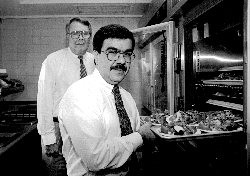
 |
On Campus: At 60,
Aaron Levin |
 For alumni, faculty or staff, the Johns Hopkins Club is a
"sanctuary," says retiring general manager Robert C. Caulfield, a
place where members can dine with friends or colleagues without
being disturbed.
For alumni, faculty or staff, the Johns Hopkins Club is a
"sanctuary," says retiring general manager Robert C. Caulfield, a
place where members can dine with friends or colleagues without
being disturbed.The Johns Hopkins Club isn't really one of those stuffy places in a New Yorker cartoon. True, there's a paneled room with a working fireplace where you might find a couple of profs sitting around discussing the cosmos. On the other hand, you might run into a wedding reception or a dinner party with some of the university's more recent Nobel Prize winners. Tucked away behind Gilman Hall on the Homewood campus, the club celebrates 60 years in its current building with much continuity and some important changes. Caulfield is retiring in stages after 21 years at the helm, his place taken by Cem (Jim) Baraz, who began working at the club as a waiter in 1975. The club itself was founded in 1899 by some faculty and graduates who sought a place where faculty and graduate students could meet each other. Alumnus Theodore Marburg made a $50,000 gift in 1907 to build a club. In 1937, he made another $50,000 gift to support the construction of the current building, built in the familiar Georgian style. One of his specific conditions was that wood-burning stoves be installed in the kitchen. His son had committed suicide with the help of a gas stove, and Marburg wanted no unhappy reminders in the club he financed. Eventually, the kitchen was brought up to the finest Depression era standards. Nearly anyone of note who has passed through the Hopkins campus has also passed through the club, from Cary Grant and Princess Grace of Monaco to Lee Iaccoca and Boris Yeltsin. The building has been renovated several times to improve operations and expand capacity. Before 1981, for example, guests had to walk through the kitchen to reach the small dining room in the back. This space, now named for Milton S. Eisenhower, was once called the "Ladies Dining Room"--another indicator of change at the university. There are also several other small or dividable rooms to give small groups of diners private spaces. In 1987, a large open area with a bar and a wall of windows was added, creating an attractive space for wedding receptions and other large events. "The club is in good shape," asserts William Single III (A&S, '57), a Baltimore attorney who is president of the club's board of governors, "but we are not free of problems." Because the Hopkins Club has no overnight or athletic facilities, it is essentially a dining club. Much of its lunch business comes when faculty and staff drop by for lunch. The dinner trade has relied for years on alumni who live near campus. Now the club faces sharper competition. Other restaurants have opened in the Homewood area and in Baltimore in general, giving members a wider choice of places to dine out. At the same time, the club feels the pinch of limited parking to accommodate visitors. Demographic factors weigh in as well. Typically, club members have been older alumni. As that generation moves into retirement homes with all-inclusive meal service, the utility of the club has waned. Appealing to younger alumni to fill this demographic gap, however, is not so easy. As undergraduates now come from and disperse to wider geographic areas, fewer young alumni stick around Baltimore. Then, too, says Single, "younger people have other things to deal with: grad school, starting families, paying off student loans." Single doesn't expect hordes of Gen-X alumni to come flocking in soon, but notes that the staff has increased the number of events designed to attract a new generation. The Tap Room, for instance, was opened a year ago and admits members without the coat-and-tie dress rule prevailing in the main dining room. "This has traditionally been a club which people joined when their kids were grown," says Caulfield. While faculty and staff keep the lunchtime business booming, a drop-off in alumni membership hurts the dinner trade. Both Caulfield and Single say that the club will continue efforts to bring in younger alumni and staff. Membership is open to people with a variety of connections to the university, including graduates, faculty, full-time grad students or postdoc fellows, certain staff members and members of the Alumni Association. Caulfield notes that there are reduced rates for members over 65 and under 30. The club has reciprocal privileges with other university clubs around the country and the world--from Newfoundland to Indonesia.
Go back to Previous Page
|